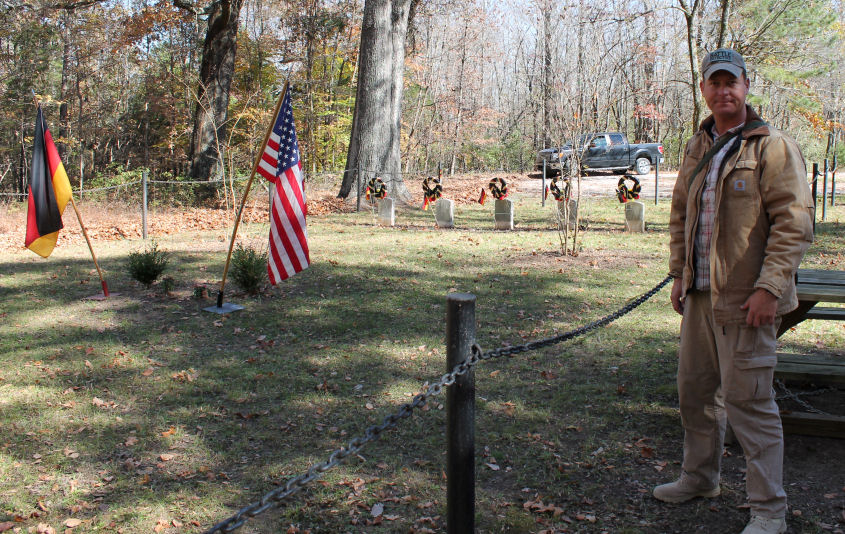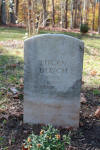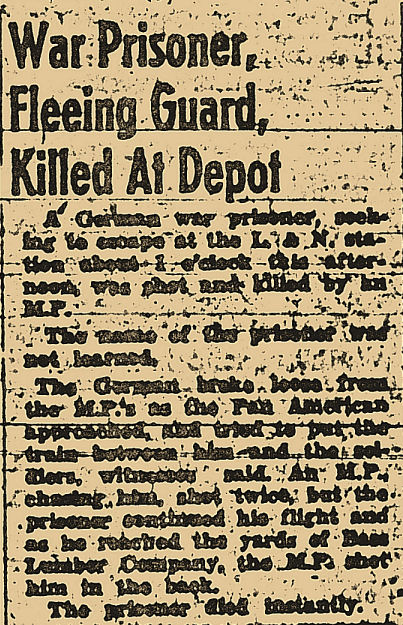|

|
|
(click to enlarge) |
|
Introduction
Each year on November 1, All Saints
Day, the Edelweiss Club of
Clarksville, Tennessee conducts a
wreath laying ceremony at the graves
of five German Prisoners of War who
died in the US Army base Camp
Campbell, Kentucky in World War Two.
We were there for the 2012 edition
of this commemorative event in what
is now known as Fort Campbell, KY.
|
|
Camp Campbell, KY
In World War Two Camp Campbell,
Kentucky was the home of the US
Army's 20th Armored Division.
When this unit was deployed
overseas, Camp Campbell became a
Prisoner of War detention facility
for the thousands of German Afrika
Korps soldiers who had been captured
in the North African campaign. Camp
Campbell was a special-purpose camp
which served as a safe haven for
dedicated "anti-Nazis"
Ironically, discipline at this camp
was often a problem as these German
democrats quarreled ceaselessly
among themselves.
In 1945 the last prisoners were
moved from the camp.
During the period in which Camp
Campbell held German POW’s, several
of them had died.
Living conditions had been good
because the USA strictly complied
with the rules set by the Geneva
Convention and therefore the
majority of these Germans died of
natural causes. |
|
 |
German Prisoners were allowed to
work for a modest wage.
An example of their work is the
Broadbent Building in nearby Cadiz
(pronounced as: "Kay Deez"),
Kentucky where POW's not only acted
as construction workers but had a
clear influence in the engineering
design:
|
|
(click for
enlargements)





 |
5 Graves
After the war only five bodies in
the same amount of graves remained
on post.
Due to the constant post-war
expansion of Camp Campbell, named
Fort Campbell today, these graves
have been moved several times.
Today they rest in what is named the
# 001 German POW cemetery in the
South-West corner of the facility.
This cemetery is on a remote and
secluded part of the Fort Campbell
US Army facility.
Well in advance we had made an
appointment with the
unit historian
of the 101st Airborne Division (Air
Assault), Captain James Page and in
his truck we drove to the cemetery. |
 |
Edelweiss Club
Upon arrival we witnessed the
preparations for the ceremony by
members of the Edelweiss Club.
This club was formed in 1981 and
organizes monthly and annual
meetings, functions and festivities
such as the Oktoberfest of
Clarksville, Tennessee.
The Edelweiss Club has taken over
the responsibility (with the
assistance of Boy Scout Troop 525)
of maintaining the Prisoner of War
Cemetery, located on Ft. Campbell.
Each 1st of November (All Saints
Day) members hold a ceremony in
keeping with German tradition,
honoring all deceased soldiers. |
Ceremony
When the time of one o’clock grew
nearer, more and more people came to
the site.
We chatted with several Edelweiss
Club members, among who was Katja.
She lives in the USA for eight years
and sings the German anthem on many
of the club’s events.
Also, several representatives of the
Fort Campbell military community
where present.
At 13:00 the ceremony started with a
welcome speech by Carl Eisemann of
the Edelweiss Club.
Eisemann retired as a US Army AH-1
Cobra Helicopter pilot in the 1990’s
and became a realtor in Clarksville.
A prayer by Fort Campbell
Installation Command Chaplain
Captain Taylor followed.
The American and German national
anthems were played followed by a
German song named "Der gute Kamerad"
sung by Edelweiss Club members.
This song, "The good Comrade", is a
traditional German mourning song.
It plays an important ceremonial
role in the German Armed Forces and
is an integral part of a military
funeral. |
|
(click for
enlargements)





 



 |
|
(click for
an enlargement)
Fort Campbell
Installation Command Chaplain
Captain Taylor |
|
After the ceremony a group photo was
taken. |
|
(click for
enlargement)
 |
The names of the German soldiers
are:
Obergefreiter Eugen Ulrich, who died
on 03 DEC 1944
Obergefreiter Kurt Franke, who died
on 02 JAN 1945
Gefreiter Herbert Lindner, who died
on 11 JAN 1945
Gefreiter Josef Reidinger, who died
22 JAN 1945
Soldat Guenter Cassens, who died on
18 SEP 1945 |
|
(click for
enlargements)
     |
|
German regular Army ranks
The ranks of these soldiers indicate
their enlistment in the German
Regular Army; not in the notorious
SS which has other rank indications.
This is consistent with the
character of Camp Campbell as an
anti-Nazi detention facility.
Except for Gefreiter Reidinger,
these soldiers died from decease
like pneumonia.
Of Reidinger it is known that he had
escaped the Camp and was caught in
the L&N Railroad station in
nearby Clarksville, Tennessee where he was shot by
Military Police personnel when he
tried to evade them. |
|

Source: Captain
James A. Page
General Staff 101st Airborne
Division (Air Assault)
|
L&N Station in Clarksville
These are some images we took
recently of the L&N Station in
Clarksville, Tennessee, made famous
by the 1960's song "Take the Last
Train to Clarksville" of The
Monkeys: |
|
(click for
enlargements)




 |
|
We have witnessed a worthy ceremony
commemorating the lives of five Word
War Two soldiers who were taken
Prisoners Of War but, despite a
decent treatment by their captors,
never returned to their fatherland. |
|
Back to Commemoration Page |













